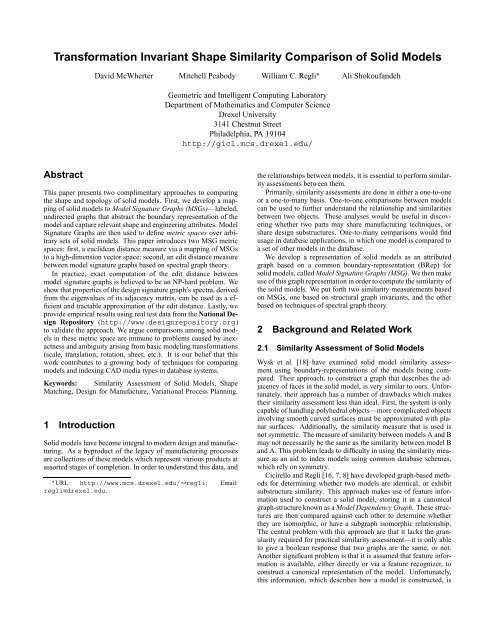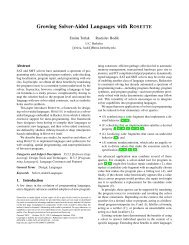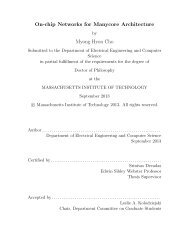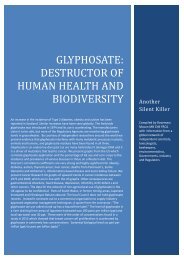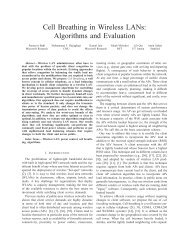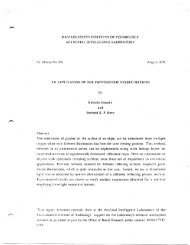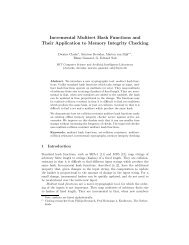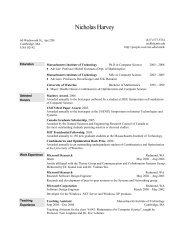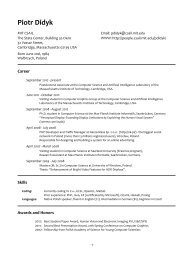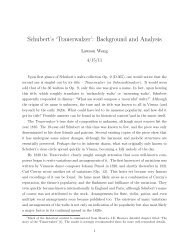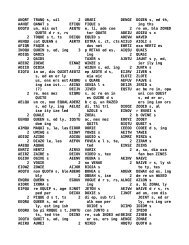Transformation Invariant Shape Similarity Comparison of Solid Models
Transformation Invariant Shape Similarity Comparison of Solid Models
Transformation Invariant Shape Similarity Comparison of Solid Models
Create successful ePaper yourself
Turn your PDF publications into a flip-book with our unique Google optimized e-Paper software.
<strong>Transformation</strong> <strong>Invariant</strong> <strong>Shape</strong> <strong>Similarity</strong> <strong>Comparison</strong> <strong>of</strong> <strong>Solid</strong> <strong>Models</strong><br />
Abstract<br />
David McWherter Mitchell Peabody William C. Regli<br />
This paper presents two complimentary approaches to comparing<br />
the shape and topology <strong>of</strong> solid models. First, we develop a mapping<br />
<strong>of</strong> solid models to Model Signature Graphs (MSGs)—labeled,<br />
undirected graphs that abstract the boundary representation <strong>of</strong> the<br />
model and capture relevant shape and engineering attributes. Model<br />
Signature Graphs are then used to define metric spaces over arbitrary<br />
sets <strong>of</strong> solid models. This paper introduces two MSG metric<br />
spaces: first, a euclidean distance measure via a mapping <strong>of</strong> MSGs<br />
to a high-dimension vector space; second, an edit distance measure<br />
between model signature graphs based on spectral graph theory.<br />
In practice, exact computation <strong>of</strong> the edit distance between<br />
model signature graphs is believed to be an NP-hard problem. We<br />
show that properties <strong>of</strong> the design signature graph’s spectra, derived<br />
from the eigenvalues <strong>of</strong> its adjacency matrix, can be used as a efficient<br />
and tractable approximation <strong>of</strong> the edit distance. Lastly, we<br />
provide empirical results using real test data from the National Design<br />
Repository (http://www.designrepository.org)<br />
to validate the approach. We argue comparisons among solid models<br />
in these metric space are immune to problems caused by inexactness<br />
and ambiguity arising from basic modeling transformations<br />
(scale, translation, rotation, sheer, etc.). It is our belief that this<br />
work contributes to a growing body <strong>of</strong> techniques for comparing<br />
models and indexing CAD media types in database systems.<br />
Keywords: <strong>Similarity</strong> Assessment <strong>of</strong> <strong>Solid</strong> <strong>Models</strong>, <strong>Shape</strong><br />
Matching, Design for Manufacture, Variational Process Planning.<br />
1 Introduction<br />
<strong>Solid</strong> models have become integral to modern design and manufacturing.<br />
As a byproduct <strong>of</strong> the legacy <strong>of</strong> manufacturing processes<br />
are collections <strong>of</strong> these models which represent various products at<br />
assorted stages <strong>of</strong> completion. In order to understand this data, and<br />
¡<br />
http://www.mcs.drexel.edu/¢ URL: regli; Email:<br />
regli@drexel.edu.<br />
Geometric and Intelligent Computing Laboratory<br />
Department <strong>of</strong> Mathematics and Computer Science<br />
Drexel University<br />
3141 Chestnut Street<br />
Philadelphia, PA 19104<br />
http://gicl.mcs.drexel.edu/<br />
Ali Shokoufandeh<br />
the relationships between models, it is essential to perform similarity<br />
assessments between them.<br />
Primarily, similarity assessments are done in either a one-to-one<br />
or a one-to-many basis. One-to-one comparisons between models<br />
can be used to further understand the relationship and similarities<br />
between two objects. These analyses would be useful in discovering<br />
whether two parts may share manufacturing techniques, or<br />
share design substructures. One-to-many comparisons would find<br />
usage in database applications, in which one model is compared to<br />
a set <strong>of</strong> other models in the database.<br />
We develop a representation <strong>of</strong> solid models as an attributed<br />
graph based on a common boundary-representation (BRep) for<br />
solid models, called Model Signature Graphs (MSG). We then make<br />
use <strong>of</strong> this graph representation in order to compute the similarity <strong>of</strong><br />
the solid models. We put forth two similarity measurements based<br />
on MSGs, one based on structural graph invariants, and the other<br />
based on techniques <strong>of</strong> spectral graph theory.<br />
2 Background and Related Work<br />
2.1 <strong>Similarity</strong> Assessment <strong>of</strong> <strong>Solid</strong> <strong>Models</strong><br />
Wysk et al. [18] have examined solid model similarity assessment<br />
using boundary-representations <strong>of</strong> the models being compared.<br />
Their approach, to construct a graph that describes the adjacency<br />
<strong>of</strong> faces in the solid model, is very similar to ours. Unfortunately,<br />
their approach has a number <strong>of</strong> drawbacks which makes<br />
their similarity assessment less than ideal. First, the system is only<br />
capable <strong>of</strong> handling polyhedral objects—more complicated objects<br />
involving smooth curved surfaces must be approximated with planar<br />
surfaces. Additionally, the similarity measure that is used is<br />
not symmetric. The measure <strong>of</strong> similarity between models A and B<br />
may not necessarily be the same as the similarity between model B<br />
and A. This problem leads to difficulty in using the similarity measure<br />
as an aid to index models using common database schemes,<br />
which rely on symmetry.<br />
Cicirello and Regli [16, 7, 8] have developed graph-based methods<br />
for determining whether two models are identical, or exhibit<br />
substructure similarity. This approach makes use <strong>of</strong> feature information<br />
used to construct a solid model, storing it in a canonical<br />
graph-structure known as a Model Dependency Graph. These structures<br />
are then compared against each other to determine whether<br />
they are isomorphic, or have a subgraph isomorphic relationship.<br />
The central problem with this approach are that it lacks the granularity<br />
required for practical similarity assessment—it is only able<br />
to give a boolean response that two graphs are the same, or not.<br />
Another significant problem is that it is assumed that feature information<br />
is available, either directly or via a feature recognizer, to<br />
construct a canonical representation <strong>of</strong> the model. Unfortunately,<br />
this information, which describes how a model is constructed, is
For Submission to the 2001 <strong>Shape</strong> Modeling Conference<br />
frequently not available in practical databases <strong>of</strong> solid models, and<br />
is difficult (if not impossible) to generate from models.<br />
2.2 <strong>Comparison</strong>s <strong>of</strong> <strong>Shape</strong> <strong>Models</strong><br />
A considerable amount <strong>of</strong> work has been done in the field <strong>of</strong> computer<br />
vision in <strong>Shape</strong> Recognition <strong>of</strong> solid objects. Typically, the<br />
approaches here assume that there is some sensed input <strong>of</strong> <strong>of</strong> the<br />
shape or object being recognized, as well as a database <strong>of</strong> solid<br />
models. Geometric Hashing is typically used in shape recognition,<br />
comparing a simple representation <strong>of</strong> the structure <strong>of</strong> the shape being<br />
examined, and the representations for the models available in<br />
the database.<br />
A common approach to computing model similarity in the field<br />
<strong>of</strong> computer vision naturally involves making use <strong>of</strong> a projection <strong>of</strong><br />
the solid model into a 2-dimensional space (such as a photograph),<br />
where the input signal is compared to the projections <strong>of</strong> model objects<br />
in a database. Given that most information about the 3-d (or<br />
higher dimensional) properties <strong>of</strong> the model are thrown away in the<br />
projection phase, techniques that make more use <strong>of</strong> the system have<br />
been developed.<br />
Aspect graphs are a common mechanism for dealing with models<br />
whose geometry and configuration are completely known. This<br />
approach computes all possible appearances that an object may take<br />
when viewed by an observer (commonly using a projection from 3d<br />
to 2-d space, for instance). These views are stored in a graph<br />
whose edges associate views when a simple spatial transformation<br />
may directly transform one view into another.<br />
Aspect graphs, however, are difficult to compute for arbitrarily<br />
solid models, and are typically restricted to objects whose boundaries<br />
can be described by simple polygonal structures or surfaces<br />
surfaces <strong>of</strong> revolution. Practical models, however, are much more<br />
complicated, however, having combinations <strong>of</strong> smooth, and polygonal<br />
surfaces. Known techniques for dealing with these more complicated<br />
systems are computationally intractable [15].<br />
2.3 Graph-based Representations<br />
In the field <strong>of</strong> pattern recognition, a number <strong>of</strong> approaches have<br />
been set forth to determine similarities between graphs. Primarily,<br />
these approaches are to construct a similarity measurement based<br />
on metric distance functions. The metric property enables the measurement<br />
to be used to aid in indexing collections <strong>of</strong> graph structures<br />
in database applications.<br />
Kubica et al. [14] make use <strong>of</strong> a distance metric known as editdistance.<br />
Edit distance is defined as the smallest number <strong>of</strong> edge<br />
rotations or additions that are needed to transform one graph into<br />
another graph. Unfortunately, computing this property <strong>of</strong> a graph<br />
is believed to be NP-hard, and no well-known approximation algorithms<br />
exist to compute it with bounded error.<br />
In addition to similarity measures based on edit-distance, a<br />
number <strong>of</strong> researchers make use <strong>of</strong> similarity measures based on<br />
the maximal common subgraph shared between two graphs [4].<br />
The technique finds the maximal common subgraph between two<br />
graphs, and computes its size with respect to the size <strong>of</strong> the graphs<br />
themselves. This measurement also constitutes a distance metric,<br />
and is also believed to be NP-hard. Approximation algorithms to<br />
compute the maximal common subgraph, however, are more readily<br />
available than those for edit-distance, however. The methodologies<br />
we develop in this paper provide similarity measures that may<br />
be used as an approximate distance metric whenever applicable.<br />
2<br />
(a) Wireframe (b) Hidden Lines Removed<br />
� � �<br />
� � �<br />
� � � � � � � � � £ ¤ ¥<br />
� � �<br />
���� ���<br />
� � � � �<br />
���<br />
� � �<br />
� �<br />
� � �<br />
� � �<br />
¡ ¡ ¢<br />
¦ ¦ §<br />
�<br />
£ £ £<br />
� � �<br />
� � �<br />
� � � � �<br />
� �<br />
� � � ¤ ¤ ¥<br />
� � �<br />
�<br />
���<br />
� � �<br />
� � �<br />
� � �<br />
� � �<br />
� � �<br />
� � �<br />
� � �<br />
� � �<br />
� � �<br />
� � �<br />
� � �<br />
¨ ¨ ©<br />
� � �<br />
� � �<br />
� � �<br />
� � �<br />
� � �<br />
� � �<br />
� � �<br />
� � �<br />
� � �<br />
� � �<br />
� � �<br />
� � �<br />
� � �<br />
© � ��<br />
���<br />
� � � §<br />
� � �<br />
� � �<br />
� � �<br />
� ��<br />
¥ �<br />
�� �� ¨ ¦ ¤ £<br />
���<br />
� � �<br />
� � �<br />
� � �<br />
� � � � � �<br />
� � �<br />
� � �<br />
�� ��� ���<br />
��� ��<br />
��<br />
��<br />
��<br />
��<br />
��<br />
�� �� ��<br />
��� ��� ��<br />
�� �� ��� ���<br />
��� ��� ��<br />
�� �� ��<br />
���<br />
�� ��<br />
�� �� �� ��� ��<br />
�� �� ����<br />
��<br />
�� �� �� ��<br />
�� �� �� ���<br />
�� �� �� �� ��<br />
�� ��<br />
�� ��<br />
�� ��<br />
��<br />
��<br />
���<br />
��<br />
��� ��<br />
��<br />
��<br />
�� ��<br />
��� ��� ���<br />
��<br />
��� ��� �� �� ��<br />
��<br />
¦ § ¦<br />
� �<br />
� � �<br />
� � �<br />
� � �<br />
�<br />
� � �<br />
� � �<br />
� � �<br />
� � �<br />
� � �<br />
� � �<br />
� � �<br />
� � �<br />
���<br />
¢ ¡<br />
���<br />
� � �<br />
© �<br />
� � �<br />
� � �<br />
� � � ¨<br />
� � �<br />
� � � � �<br />
� � �<br />
� � �<br />
�<br />
� � � � � �<br />
� � �<br />
���<br />
���<br />
� � �<br />
���<br />
� � �<br />
���<br />
� � �<br />
� � �<br />
� � �<br />
� � �<br />
� �<br />
� � �<br />
�<br />
� � �<br />
� � �<br />
� � �<br />
� � �<br />
� � �<br />
� � �<br />
� � �<br />
� � �<br />
� � �<br />
� � �<br />
� � �<br />
� � �<br />
� � �<br />
� � �<br />
� � �<br />
� � �<br />
� � �<br />
� � �<br />
� � �<br />
� � �<br />
� � �<br />
� � ��� ���<br />
�<br />
� � �<br />
� � ���<br />
��� �<br />
� � �<br />
���<br />
� � �<br />
� � �<br />
� �<br />
� � � �<br />
� � �<br />
� � �<br />
� � �<br />
� � �<br />
� � �<br />
� � �<br />
� � �<br />
���<br />
���<br />
� � �<br />
� � � � �<br />
�<br />
� � �<br />
� � �<br />
���<br />
� � �<br />
���<br />
���<br />
� � �<br />
� � �<br />
� � �<br />
� � �<br />
� � �<br />
��<br />
� � �<br />
�¢£¤ ��� ��� ��� ��� ���<br />
��� ��� ��� ��� ��� ���<br />
��� ��� ���<br />
���<br />
���<br />
��� ��� ���<br />
� �<br />
� � ��� �<br />
���<br />
� � ��� ���<br />
���<br />
��� ��� ���<br />
�<br />
���<br />
� � �<br />
���<br />
���<br />
���<br />
��� ��� ��� ���<br />
� � �<br />
� �<br />
���<br />
�<br />
��� ��� ���<br />
���<br />
� � �<br />
� � �<br />
� � �<br />
� � �<br />
� � �<br />
� � �<br />
� � �<br />
� �<br />
� � �<br />
�<br />
� � �<br />
���<br />
� � �<br />
��<br />
� � � � � �<br />
��<br />
� � �<br />
� � �<br />
� � �<br />
� � � � � �<br />
��<br />
��<br />
�� ��<br />
�� ��<br />
��<br />
�� �� ��<br />
�� ��<br />
��<br />
��<br />
�� ��<br />
�� �� �� ��<br />
��� ��� �� ��<br />
� � ¥¦§ �<br />
� � �<br />
�<br />
� � �<br />
� � ¡ ��� ��� ��� ���<br />
�<br />
� � ���<br />
�<br />
� � � � � �<br />
� � �<br />
���¨©�<br />
���<br />
���<br />
���<br />
� � �<br />
� � �<br />
���<br />
� � �<br />
���<br />
���<br />
��� ���<br />
� � �<br />
���<br />
���<br />
���<br />
���<br />
���<br />
��� ���<br />
���<br />
���<br />
(c) Model Signature Graph<br />
Figure 1: Representations <strong>of</strong> the Torpedo model as a solid model<br />
and MSG.<br />
3 Problem Statement and Technical Approach<br />
3.1 Model Signature Graphs<br />
We make use <strong>of</strong> a specialized graph structure in order to represent<br />
solid models in order to perform similarity comparisons. This structure,<br />
called a Model Signature Graph (MSG), is constructed from<br />
the boundary representation <strong>of</strong> a solid model in a manner similar<br />
to that by Wysk et al. [18] and the Attributed Adjacency Graph<br />
(AAG) structures used to perform Feature Recognition from solid<br />
models [13].<br />
The boundary representation (BRep) [12] essentially consists <strong>of</strong><br />
a set <strong>of</strong> edges and a set <strong>of</strong> faces used by the solid modeler to describe<br />
the shape <strong>of</strong> the model in 3-dimensional space. An MSG<br />
for a solid model �<br />
is defined as a labeled ������������� graph, ,<br />
where each face ���<br />
�<br />
���<br />
���<br />
� � �<br />
���<br />
���<br />
� � �<br />
� � �<br />
� � �<br />
� � �<br />
���<br />
���<br />
is represented as a vertex ��� � , with at-<br />
tributes that further describe the qualities <strong>of</strong> the face in the model.<br />
For instance, we record the type <strong>of</strong> the surface (e.g., flat or curved),<br />
the relative size, and other physical attributes <strong>of</strong> the face with the<br />
vertex, including:<br />
1. topological identifier for the face (planar, conical, etc.);<br />
2. underlying geometric representation <strong>of</strong> the surface, i.e. the<br />
type <strong>of</strong> function describing the surface;<br />
��<br />
��<br />
� � �<br />
� � �
For Submission to the 2001 <strong>Shape</strong> Modeling Conference<br />
3. surface area, � ¡£¢¥¤¦¡ , for the face;<br />
4. set <strong>of</strong> surface normals or aspects for � .<br />
An MSG edge § � � exists whenever two faces<br />
�©¨ �������<br />
� � �<br />
�<br />
� adjacent—i.e., when � ¨ and � � meet at an edge � in the<br />
� ¨<br />
BRep. The MSG edge § � � � � is attributed with features rep-<br />
� ¨<br />
resenting the type <strong>of</strong> � BRep edge, , connection that is being used,<br />
including:<br />
1. topological identifier for the edge � in the model �<br />
2. concavity/convexity <strong>of</strong> � ;<br />
3. underlying geometric representation <strong>of</strong> the curve <strong>of</strong> � , i.e. the<br />
type <strong>of</strong> function describing the curve;<br />
4. the length <strong>of</strong> the curve <strong>of</strong> � .<br />
Thus, MSGs are representable as undirected graphs with labeled<br />
edges and vertices. MSGs are capable <strong>of</strong> representing either individual<br />
parts or collections <strong>of</strong> parts—the connected components<br />
within the MSG each represent one <strong>of</strong> the parts making up the collection.<br />
There is no significant restriction on the attributes stored<br />
on the vertices and edges in a MSG. The selection to be used in<br />
applied systems will most likely be tailored to meet the needs <strong>of</strong><br />
the particular application. We assume that for the most part, little<br />
information aside from the BRep is available for the construction<br />
<strong>of</strong> MSGs.<br />
These attributes represent a substantial amount <strong>of</strong> the structure<br />
contained within common BRep models, and will enhance model<br />
comparisons by aiding in the differentiation <strong>of</strong> edges and faces in<br />
the models. In addition, the attributes are easily computed from<br />
BRep models, which make them extremely practical.<br />
We believe that some attributes, such as the modeling features<br />
that are used to generate faces and edges in the BRep, may be<br />
very important in the matching process during practical use. Unfortunately,<br />
deriving this information from pure BRep data is an<br />
extremely difficult process, and may not be worth the gains in performance<br />
<strong>of</strong> the similarity measures. Further work must be done<br />
before we incorporate such attributes in our MSGs for comparisons.<br />
Example. Figure 2.3 illustrates a transformation from the<br />
boundary representation <strong>of</strong> the solid model for a torpedo motor into<br />
a Model Signature Graph. The complexity <strong>of</strong> the relationships between<br />
the faces and edges in the BRep <strong>of</strong> this model gives a good<br />
idea <strong>of</strong> the difficulty <strong>of</strong> performing shape similarity based on BRep<br />
data. Good practical algorithms in the research literature for determining<br />
the similarity <strong>of</strong> adjacency structures <strong>of</strong> this form are scarce.<br />
Making use <strong>of</strong> MSGs for similarity assessment proves to be an extremely<br />
challenging problem to solve.<br />
3.2 Metric Spaces <strong>of</strong> <strong>Solid</strong> <strong>Models</strong><br />
A metric space is a collection <strong>of</strong> objects along with a distance function,<br />
� ��� , known as the metric, which computes a distance between<br />
any two elements in the set. The distance function � ��� ��� � must<br />
satisfy a few conditions:<br />
��� ��� ����������� ����� Identity<br />
�<br />
��� �£� ������� Positivity<br />
�<br />
��� ��� ����� ��� ��� ��� Symmetry<br />
�<br />
� ��� �£� ����� ��� ��� ����� ��� ��� ��� Triangle Equality<br />
A collection <strong>of</strong> objects may naturally have more than one distance<br />
function, inducing a number <strong>of</strong> metric spaces that are able to<br />
be constructed over the objects.<br />
;<br />
3<br />
The constraints provided by the distance metric provides a significant<br />
amount <strong>of</strong> structure that can be exploited when working<br />
with metric spaces. Recently, in the field <strong>of</strong> databases and indexing,<br />
a large amount <strong>of</strong> research has been put forth to store data in metric<br />
spaces using various tree-structures [3, 6, 10] for efficient search<br />
and retrieval. Additionally, clustering and knowledge-discovery<br />
techniques such as � -means or � -median make use <strong>of</strong> metric distance<br />
functions to order and discover patterns and statistical distribution<br />
<strong>of</strong> data.<br />
We believe that a number <strong>of</strong> metric distance functions can be<br />
used to perform similarity assessment <strong>of</strong> the shapes <strong>of</strong> solid models.<br />
These functions constitute a “plug-in” module that can be tailored<br />
to perform a wide range <strong>of</strong> similarity measures based on the nature<br />
<strong>of</strong> the application.<br />
In order to make use <strong>of</strong> distance metrics in a practical system,<br />
they must be relatively easy to compute. The algorithmic complexity<br />
in computing distance metrics for arbitrarily-formed graph<br />
structures is unfortunately an open question.<br />
Given a machine to compute a distance metric between two<br />
graphs, one can trivially decide whether two graphs are isomorphic.<br />
They are isomorphic if and only if the distance between them<br />
is zero. As a result, graph isomorphism is Turing-reducible to the<br />
computation <strong>of</strong> any graph distance metric, and asymptotic computing<br />
time will be related to the complexity <strong>of</strong> algorithms to compute<br />
graph isomorphism.<br />
Graph isomorphism is a problem that has been studied for<br />
decades due to its wide range <strong>of</strong> applications. Despite the large<br />
amount <strong>of</strong> energy spent on the problem, no algorithm has been<br />
developed that has reduced its worst-case running time to subexponential.<br />
Surprisingly, it is also unknown whether the problem<br />
is truly NP-hard or not.<br />
The difficulties involved in understanding and solving the graph<br />
distance metric problem dictates the development <strong>of</strong> approximation<br />
algorithms to efficiently compute distances between Model Signature<br />
Graphs.<br />
3.3 Graph Invariance Vectors<br />
The eventual aim <strong>of</strong> our work is to enable indexing and quick retrieval<br />
<strong>of</strong> a large repository <strong>of</strong> CAD models. Although, a measure<br />
such as edit distance provides a proven metric for graph similarity,<br />
the cost <strong>of</strong> running the algorithm is much too high for a database<br />
that could potentially consist <strong>of</strong> thousands <strong>of</strong> designs. Using graph<br />
invariants, we can form groups, or clusters <strong>of</strong> potentially isomorphic<br />
graphs, or graphs that are close enough in similarity to satisfy a<br />
query. Since the goal <strong>of</strong> this paper is simply to show that clustering<br />
based on invariants is a useful means to an end, various clustering<br />
methods have been chosen to illustrate feasibility. Run-time is not<br />
an issue at this point, the primary interest being whether or not the<br />
clustering provides suitable results for further research.<br />
The graph invariants that we focus on are directly related to the<br />
degree sequence <strong>of</strong> a graph. The degree sequence, while not the<br />
most powerful invariant known, is easily computable, and can be<br />
exploited to recover general structural properties <strong>of</strong> the graph. We<br />
attempt to construct these invariants such that they are normalized,<br />
and do not depend on differences <strong>of</strong> scale in the number <strong>of</strong> edges or<br />
vertices. The following graph invariants were chosen for inclusion<br />
in our system:<br />
1. Vertex and Edge Count—Trivially computable graph invariants.<br />
Unfortunately, they reveal practically no information<br />
about the graph structure, and may be weighted too strongly in<br />
the comparisons we perform, skewing our similarity metrics.<br />
2. Minimum and Maximum Degree—Provide a measurement<br />
<strong>of</strong> the maximum and minimum number <strong>of</strong> adjacencies between<br />
one face and the other faces in the model.
For Submission to the 2001 <strong>Shape</strong> Modeling Conference<br />
3. Median and Mode Degree—Provides a measurement that<br />
represents statistically the most common and “average” cardinalities<br />
<strong>of</strong> adjacencies between faces in a model.<br />
4. Diameter – The longest path <strong>of</strong> edge/face crossings between<br />
any two faces in the model.<br />
5. Type Histogram – Each model BRep contains a set <strong>of</strong> faces<br />
and edges which have various types and features. The analysis<br />
and statistical breakdown <strong>of</strong> these component types is used to<br />
further generate a representation <strong>of</strong> the model.<br />
A set <strong>of</strong> graph invariants can be used to tell if two graphs have<br />
the potential to be isomorphic or not, but can not be used to give a<br />
definitive answer. To clarify, if the invariants <strong>of</strong> two graphs are different,<br />
there is no way the graphs can be isomorphic; if the invariants<br />
are all equal, then the graphs may or may not be isomorphic.<br />
We encode a fixed set <strong>of</strong> invariants as an <strong>Invariant</strong> Topology Vector<br />
(ITV). ITVs gives us the ability to determine a “position” for a<br />
graph in the metric space relative to other graphs. Graphs with similar<br />
values for invariants will lie in the same region <strong>of</strong> the metric<br />
space.<br />
Using graph invariants helps prune out graphs which have no<br />
similarity to a given graph and does not depend on the application <strong>of</strong><br />
the technique. However, we would like to be able to tailor it in some<br />
fashion to a particular domain to aid in more precise measurements.<br />
In generating the MSG from the model, we put labels on the<br />
vertices and edges. We would like to use these values in our ITV<br />
to give even finer granularity in our assessment. However, since<br />
there are varying numbers <strong>of</strong> vertices and edges in the graphs, the<br />
labels can not be used directly. The ACIS <strong>Solid</strong> Modeler from Spatial<br />
Technologies is the modeling system used in our experiments.<br />
ACIS has 13 different surface types, and 8 different curve types. We<br />
modify the definition <strong>of</strong> the ITV to include 21 additional values. In<br />
effect, we create a histogram <strong>of</strong> the number <strong>of</strong> times particular surface<br />
and edge types occur in the model. Thus, the ITV is a point in<br />
29 dimensions.<br />
3.4 EigenDistance<br />
We primarily focus on techniques <strong>of</strong> spectral graph theory as a basis<br />
to approximate graph similarity. Spectral graph theory is the<br />
study <strong>of</strong> the adjacency matrix <strong>of</strong> graphs using linear algebra — particularly<br />
the study <strong>of</strong> their eigenvalues and how they relate to other<br />
properties and features <strong>of</strong> a graph.<br />
The spectrum <strong>of</strong> a graph—the sorted eigenvalues <strong>of</strong> its adjacency<br />
matrix, holds a tremendous amount <strong>of</strong> information related to the<br />
structure and the topology <strong>of</strong> a graph. It has been used in numerous<br />
applications for the purposes <strong>of</strong> graph partitioning [11] and geometric<br />
hashing in vision recognition [17].<br />
There are a number <strong>of</strong> different adjacency matrices that are used<br />
in spectral graph theory to generate a graph’s spectrum. Biggs [2],<br />
for instance, uses a common form:<br />
� if � is adjacent to �<br />
���<br />
otherwise. �<br />
���<br />
Chung [5], proposes the use <strong>of</strong> an alternative “normalized” form<br />
<strong>of</strong> the graph adjacency matrix, which takes into consideration the<br />
degrees <strong>of</strong> the vertices in the graph to determine the entries in the<br />
matrix. This form, known as the graph Laplacian, has eigenvalues<br />
that have well-known and powerful relationships with other graph<br />
properties, such as the graph diameter. The Laplacian is formally<br />
defined as follows:<br />
���<br />
��� � � ���<br />
��� � � �����<br />
� �<br />
���<br />
�<br />
� � if �����<br />
� ¨<br />
�<br />
�<br />
and<br />
�<br />
�<br />
if � and � are adjacent,<br />
� ������� �<br />
��� otherwise.<br />
��� ,<br />
�<br />
4<br />
In addition to the relationship between the Laplacian spectrum and<br />
other graph invariants, as well as the fact that the normalization<br />
helps to reduce the effect <strong>of</strong> irregular degrees on graph vertices, we<br />
chose to make use <strong>of</strong> the Laplacian matrix for our approach.<br />
3.4.1 Spectral Hashing<br />
A primary goal <strong>of</strong> the distance metric is to ensure that two identical<br />
graphs have no distance between them. In addition, two graphs<br />
with only minor differences should consistently be measured relatively<br />
closely. To achieve this requirement, we first compute the<br />
eigenvalue spectrum <strong>of</strong> the graph. This operation can be done during<br />
a preprocessing phase, and the results stored for later use, if a<br />
model <strong>of</strong> reference Model Signature Graphs are being used in an<br />
application. From this point on, we consider this spectrum to be a<br />
projection <strong>of</strong> the graph from the space <strong>of</strong> graphs to ��� , and we use<br />
this space as a basis for most distance computations that make up<br />
the metric.<br />
Distance computations between the image <strong>of</strong> graphs in � � are<br />
done using any one <strong>of</strong> a number <strong>of</strong> vector-based metric norms. In<br />
particular, are investigating the use <strong>of</strong> ��� , ��� , and other norms.<br />
3.4.2 Substructure <strong>Comparison</strong><br />
A reasonable measure <strong>of</strong> similarity between graphs relies on the<br />
concept <strong>of</strong> shared substructure [4]. Semantically, two graphs that<br />
have similar common substructures themselves will tend to be similar.<br />
We believe that substructure similarity is central to most practical<br />
applications <strong>of</strong> shape recognition.<br />
We make use <strong>of</strong> substructure information in the following manner.<br />
After computing the eigenvalue spectrum for a graph, we partition<br />
the graph into two or more subgraphs, removing the edges that<br />
cross the partition(s). If this is done wisely, it will isolate highly<br />
connected component graphs at each level <strong>of</strong> the recursion. We<br />
generate the eigenvalue spectrum for each component, and recursively<br />
partition and index again.<br />
Optimally partitioning a graph to minimize the number (or<br />
weight) <strong>of</strong> the edges that cross the partition is itself an NP-hard<br />
problem. In order to make the problem more tractable, we make<br />
use <strong>of</strong> an approximation to partitioning using the eigenvalues that<br />
were computed for the graph. The technique, known as Spectral<br />
Graph Partitioning, puts the ���¦� vertices into one <strong>of</strong> two subgraphs<br />
based on the sign <strong>of</strong> the corresponding entry in the eigenvector corresponding<br />
to the second smallest eigenvalue (also known as the<br />
Fiedler Vector). Thus, with little added asymptotic complexity, the<br />
graph can be decomposed into two halves, and the process may be<br />
repeated.<br />
4 An Example<br />
We apply the techniques discussed to construct the ITVs and eigenvalue<br />
spectra required to perform distance computations on a simple<br />
model available in the National Design Repository [1], to<br />
demonstrate the transformations we use to perform shape recognition<br />
and matching. We will employ the solid model depicted in<br />
Figure 2: the spinner3 model, a simple practical model found in<br />
industry with an extremely simple BRep.<br />
ITV. First, we compute the ITV associated with the model. The<br />
following table depicts the graph invariant attributes associated with<br />
the MSG for spinner3:
For Submission to the 2001 <strong>Shape</strong> Modeling Conference<br />
�<br />
�<br />
�<br />
���<br />
� ¨ ��� ¨ ��� ¨ ��� ¨�� ��� ¨�� ��� ¨�� ��� ¨ ��� ¨ ��� ¨ ��� ¨ ��� ¨�� ��� ¨ ��� ¨ ��� ¨ ��� ¨�� ��� �<br />
��¨���� ��� � ��� � ��� ��� ��� �������������������������������<br />
� �<br />
¨�� ��� ���<br />
�������������<br />
���<br />
�<br />
�<br />
��� ��������������� ��� � ���<br />
�<br />
������������� �<br />
��� ����¨���������������������������� ��� � ¨�����¨��������<br />
� ��� � ¨ ��� ������¨ ��� ����� ��� �������������������������������<br />
��� ¨ ��� ����� ��� ��¨ ��� �����������������������������������<br />
��� ¨ ��� ������� ��� ��¨�� ��� �������������������������������<br />
��<br />
� ��������������¨ �<br />
��� � ��� ����� ��� ������������������� ��� ���<br />
��� ¨ ��� ��� ��� � ��� ��� ��� � ��� ��¨ ��� � ��� ��������� ��� ¨�� ��� ¨�������� ��� ���<br />
������������� ��� � ��� ��¨ ��� ��� ��� �����������������������<br />
���<br />
�<br />
��� � ��� ��¨�� ��� �����������������������<br />
� ¨��������������<br />
� ����������������������¨ �<br />
��� � ��� � ��� � ��� �����������������<br />
��� ¨������������ ��� ��� ��� � ��� � ��� ��¨ ��� ��� ��� ¨������������ ��� ���<br />
��� ¨�������������������� ��� � ��� ��¨ ��� �������������������<br />
�<br />
¨�������������������� ��� ��� ��� ��¨ ��� �����������������<br />
� ���<br />
� ��� ¨�������������� �<br />
��� ¨���� ��� � ��� ¨�� ��� ��¨ ��� � ��� ¨�������� ��� ���<br />
��� ¨���� ��� ����������������������� ��� ��¨ ��� �������������<br />
��� ��� � ��� ��������� ��� ¨������������ ��� ¨ ��� ��¨ ��� � ��� � ��� � ��� ��� ��� �<br />
���<br />
¨�������������������������������� ��� ��¨ ��� ��� ��� �����<br />
��� ¨�������������������������������� ��� � ��� ��¨ ��� �������<br />
���<br />
¨�������������������������������� ��� ��� ��� ��¨ ��� �����<br />
��� ¨�������������������������������� ��� � ��� ��� ��� ��¨����<br />
���<br />
��� � ��� ������� ��� ����� ��� ��������������¨��<br />
��� ��������������������������������� ��� ������������¨<br />
�������������<br />
� ��� ����� ����� ����� �<br />
� � ����� ��� � �����<br />
����� � � � � � �<br />
� ����� � �������������<br />
�<br />
� � �<br />
� �<br />
�<br />
� � �<br />
� �<br />
�<br />
� � �<br />
� �<br />
�<br />
� � �<br />
� �<br />
�<br />
� � �<br />
� �<br />
�<br />
����� � � � �<br />
� ��� � �<br />
Figure 3: Laplacian matrix and eigenvalue spectrum computed for the spinner3 model.<br />
����������� ������������� ������������� ���������<br />
�����¥�<br />
���������������������<br />
�����������<br />
�������������<br />
��������������� ���<br />
�������������<br />
Figure 2: An example <strong>of</strong> our approach: encoding <strong>of</strong> the spinner3<br />
model into an MSG, which is then used to create the ITV and<br />
EigenDistance vector spaces.<br />
Attribute Value<br />
Vertex Count 24<br />
Edge Count 63<br />
Degree Max 2<br />
Degree Min 17<br />
Degree Mode 4<br />
Degree Median 4.00<br />
Degree Std. Deviation 3.27<br />
Graph Diameter 3<br />
The computation <strong>of</strong> these attributes is relatively straightforward.<br />
The only attribute that we are currently concerned with that is not<br />
computable in time linear in the number <strong>of</strong> edges is the graph diameter.<br />
We are able to compute graph diameter in two ways. In<br />
one implementation, the diameter is computed using an all-pairs<br />
shortest-path algorithm, such as the Floyd-Warshall algorithm [9],<br />
5<br />
which can be computed in � ��� ��� � � , for graphs <strong>of</strong> � ��� vertices. An<br />
alternative method uses an upper bound for the diameter, computed<br />
from the eigenvalue spectra [5]. This upper bound is stated as follows:<br />
�<br />
��� ���<br />
���¥��� � � �¥���������©������� � �����<br />
�©��� � � �©�<br />
�<br />
where � � is the � -th largest eigenvalue in the eigenvalue spectrum,<br />
and � is the number <strong>of</strong> eigenvalues in the spectrum (which is equal<br />
to the number <strong>of</strong> vertices in the graph). We investigate the use <strong>of</strong><br />
this as an approximation <strong>of</strong> graph diameter as if both our eigenvalue<br />
metric and the invariance metrics are being used, the computation<br />
<strong>of</strong> graph diameter is done at effectively no added cost.<br />
Eigenvalue Metric. In order to compute the eigenvalue similarity<br />
measure we must first compute the Laplacian matrix for the<br />
spinner3 model, and then compute its eigenvalue spectrum. Both<br />
the Laplacian matrix ( �<br />
�<br />
), and the eigenvalue spectrum ( � ) com-<br />
puted from the spinner3 model are depicted in Figure 3. We compute<br />
the eigenvalues <strong>of</strong> the system with s<strong>of</strong>tware packages that use<br />
a Householder-��� matrix diagonalization algorithm, which efficiently<br />
generates the eigenvalues in time cubic in the number <strong>of</strong><br />
vertices <strong>of</strong> the graph.<br />
The ITV and the eigenvalue vector can be compared using standard<br />
vector norms in � � . In the case <strong>of</strong> comparing graph spectra,<br />
small provisions must be made for comparing graphs with differing<br />
number <strong>of</strong> vertices, as spectrum vectors <strong>of</strong> different lengths must<br />
be compared. Currently, we simply remove the smallest eigenvalues<br />
from the larger vector, and compute standard ��� (Euclidean)<br />
and ��� norms.<br />
5 Empirical Results<br />
We investigate the application <strong>of</strong> the � measures on models found<br />
in the National Design Repository [1]. We� have � computed the<br />
distances between each a collection <strong>of</strong> models using both �<br />
the<br />
��� �¦����������� eigenvalue spectrum similarity measure ), �<br />
and<br />
(���<br />
the (��� � �¦����������� graph invariant topology vector measure ). The<br />
computations that we have done make use <strong>of</strong> a<br />
�¦�����������<br />
���<br />
���<br />
�<br />
��<br />
��<br />
��<br />
��<br />
��<br />
��<br />
��<br />
��<br />
�<br />
�
For Submission to the 2001 <strong>Shape</strong> Modeling Conference<br />
�����������¨�£���<br />
�¨� �����£������� ����������� ���<br />
������¨�£���<br />
�¨� �����£������� ����������� ���<br />
�¨�������<br />
�������������������¦� ���<br />
������¦�£������<br />
£¢¥¤ ¦¨§ ©����¨��� ��� ����������� ���<br />
���¡<br />
�������¥�������������<br />
���������������������<br />
�����£�¥� �¨� �����¨��� ��������������� ���<br />
���<br />
�£� �����¨��� ��������������� ���<br />
�¨�¡�£�¥�<br />
Figure 4: <strong>Similarity</strong> comparison between spinner3, spinner4, and part01.<br />
���������¥���������������<br />
���£�¥��� �¨� �����¨������� ����������� ���<br />
���<br />
�¨� �����¨������� ������������� ���<br />
�¨���¨���<br />
��� �����¨��� ��� ����������� ���<br />
��������¨���<br />
�¨� ��������� ��� ����������� ���<br />
�����¨���<br />
�������������������<br />
���������¥���������������<br />
£¢¥¤�� ¦¨§ ©�¢��¨ �� ��������������� ���<br />
����¡<br />
�¨� �����¥��� ����������������� ���<br />
�¨���¥���<br />
Figure 5: <strong>Similarity</strong> comparison between Team Part-1, Team Part-2, and 3tmount.<br />
non-recursive version <strong>of</strong> the method, which we expect limits its<br />
ability to do substructure similarity assessment. Figures 4, 5, 6,<br />
and 7 depict the similarity measures between triples <strong>of</strong> models that<br />
we have selected to highlight various properties <strong>of</strong> our approaches.<br />
Example 1. The first triplet <strong>of</strong> models, shown in Figure 4, is<br />
made up <strong>of</strong> parts known as part01, spinner3, and spinner4. These<br />
are fairly simple industrial models, and their relationship under both<br />
distance measures is illustrated in Figure 4. Visually, one would<br />
expect that spinner3 and spinner4 would be more similar to one<br />
another, which is contradictory to the results attained by both <strong>of</strong><br />
our similarity metrics. More interestingly, this is consistent for<br />
both similarity measures. Our interpretation is that the measures<br />
are picking up on a similarity in the model complexity in spinner3<br />
and part01, given that spinner4 is a noticeably more complex part<br />
with a greater number <strong>of</strong> geometric and topological entities.<br />
Example 2. The second triple, shown in Figure 5, consists <strong>of</strong><br />
models from the US Department <strong>of</strong> Energy’s Technologies Enabling<br />
Agile Manufacturing (TEAM) Program. The Team Part-<br />
1, Team Part-2, and 3tmount. Team Part-1 and Team Part-2 are<br />
6<br />
benchmark parts made to test process planning applications, exhibit<br />
striking similarity, although their scales and orientation in the<br />
Repository are different. 3tmount is an actual model from industry,<br />
and is considerably different from either Team Part-1 or Team Part-<br />
2. As is depicted in Figure 5, the distance measures seem to agree<br />
with visual intuition. The Team Part-1 and Team Part-2 models are<br />
considered to be far more similar than 3tmount.<br />
Example 3. The third set <strong>of</strong> models is made up <strong>of</strong> STI-Simple,<br />
STI-Boeing, and Chamber, and are shown in Figure 6. These parts<br />
are taken from industry, the first two contributed to the Design<br />
Repository by the Boeing Aircraft Company. Note that they exhibit<br />
slightly more complexity than is found in the first sets <strong>of</strong> models.<br />
To the human observer, STI-Simple and STI-Boeing are variations<br />
on a common structure, whereas the Chamber is an extremely different<br />
model, whose curves and shape bears little resemblance to<br />
the other two. The distance measures also appear to correlate with<br />
visual intuition. In addition, it may be noted that the distances computed<br />
between Chamber and the other two parts are extremely similar.<br />
This is likely to be due to the fact that there is largely a 1-to-1<br />
correspondence between faces and edges in the STI models, which
For Submission to the 2001 <strong>Shape</strong> Modeling Conference<br />
makes their MSGs extremely similar.<br />
����������������������� �<br />
���¥����� ��� ������������� ¢¡¤£¦¥¨§�© �¨�<br />
���<br />
��� �������¨����� �¢�¤�¦�¨����� ���<br />
���������<br />
���¥����� ��� �����¥��� ��� ����������� ���<br />
���<br />
��� ��������� ��� ����������� ���<br />
�¥�������<br />
�������������������<br />
�������������������������<br />
���¨����� �¥� ��������� ��������������� ���<br />
���<br />
�¥� ��������� ����������������� ���<br />
�¥�������<br />
Figure 6: <strong>Similarity</strong> comparison between STI-Boeing, STI-Simple, and Chamber.<br />
�������������������¦��� �����<br />
�¢�����¤� ��� �¨����������� ����������� ���<br />
���<br />
��� �¨����������� ������������� ���<br />
�������¤�<br />
�¢�����¤� ��� �¨������� ��� ���¤���¨���¨� ���<br />
���<br />
��� �¨������� ��� ������������� �¨���<br />
�������¤�<br />
�������������������¦��� �¤���<br />
�������������������¦��� ���������<br />
�¢������� ��� �¨������� ����������������� ���<br />
���<br />
��� �¨������� �����������¨���¨� ���<br />
���������<br />
Figure 7: <strong>Similarity</strong> comparison between ToolingBlock, ToolingBlock-1, and ToolingPlate.<br />
Example 4. The final set <strong>of</strong> models we examine is made up <strong>of</strong><br />
ToolingBlock, ToolingBlock-1, and ToolingPlate, and are shown in<br />
Figure 7. These are also industrial fixturing models, but they have<br />
a large amount <strong>of</strong> detail on multiple scales, made up primarily <strong>of</strong><br />
general shape, then <strong>of</strong> the many small holes on each surface. The<br />
distances between these models does not appear to follow human<br />
intuition on the large-scale, on which ToolingBlock would be extremely<br />
similar to ToolingBlock-1, as opposed to ToolingPlate. To<br />
mimic human interpretation in this example, filtering <strong>of</strong> some form<br />
must be applied to perform multi-scaled comparisons <strong>of</strong> the models.<br />
Although not readily apparent in the figures, each <strong>of</strong> these parts<br />
is stored in the Design Repository [1] with differing scales, and<br />
transformations. It is essential to note that our similarity measures<br />
have no difficulty performing the comparisons between the objects<br />
7<br />
based purely on their shape and structure, regardless <strong>of</strong> these transformations.<br />
The selected comparisons illustrate the metric properties <strong>of</strong> our<br />
similarity measures. Take, for example, �<br />
the �<br />
comparison between<br />
Team Part-1, Team Part-2, and 3tmount. Tables 4 and 4 �<br />
provides<br />
verification that the triangle inequality is obeyed by both the<br />
similarity measures.<br />
�¦�����������<br />
���<br />
���<br />
�¦����������� and ��� �<br />
The central conclusion is that the “length” <strong>of</strong> the path between<br />
two models that passes through an intermediate is longer than the<br />
direct path between the models. This is a realization <strong>of</strong> the triangle<br />
inequality, and is a key property <strong>of</strong> our distance measures.<br />
It should be noted that our similarity measures only approximate<br />
metric functions, and models may be found for which the triangle<br />
inequality does not hold.
For Submission to the 2001 <strong>Shape</strong> Modeling Conference<br />
A B C<br />
1 part01 spinner3 spinner4 �����<br />
EigD(A,B) + �<br />
�����������������<br />
EigD(B,C)<br />
EigD(B,C) + �<br />
�����������¦�����<br />
EigD(C,A)<br />
EigD(C,A) + �<br />
�����������������<br />
EigD(A,B)<br />
�<br />
�<br />
�<br />
��������� ����� ��� ��� ��� ��� � ����� �<br />
�����<br />
��� ����� ����� ����� ���<br />
� �<br />
����� � ����� � ��� ����� ����� ���<br />
��� ��� ����� � ����� ���������©� ���<br />
� � � � �<br />
�<br />
����� ��� ���������©� �<br />
������� ���<br />
������� � � �����<br />
��� ����� ��� ����� ����� ����� ���<br />
�<br />
2<br />
3<br />
4<br />
Team Part-1<br />
STI-Simple<br />
ToolingBlock<br />
Team Part-2<br />
STI-Boeing<br />
ToolingBlock-1<br />
3tmount<br />
Chamber<br />
ToolingPlate<br />
A B C<br />
Table 1: Verification <strong>of</strong> the triangle inequality for ���<br />
ITVD(A,B) + ITVD(B,C) �<br />
�����¤�����������<br />
���<br />
�¦����������� .<br />
ITVD(B,C) + �<br />
�����������¦�����<br />
ITVD(C,A)<br />
��� ���<br />
ITVD(C,A) + ITVD(A,B) �<br />
� � � �<br />
�<br />
� � � ����� ��� ��� ����� ���������©� �<br />
1 �<br />
part01 �<br />
spinner3 spinner4 ����� �����������<br />
������� ����� ����� ��� ������� ����� ����� ��� � ��� ����� ������� ���<br />
�<br />
2 Team Part-1 Team Part-2 3tmount<br />
���<br />
3<br />
4<br />
STI-Simple<br />
ToolingBlock<br />
STI-Boeing<br />
ToolingBlock-1<br />
Chamber<br />
ToolingPlate<br />
6 Discussion and Conclusions<br />
�����¤�����¤�����<br />
������������� ������� ��� ������� ������������� ���<br />
� � � ��� � �����������<br />
��� ��� �����©� �����������©� ��� ������� ������������� ���<br />
� ����� �������<br />
Table 2: Verification <strong>of</strong> the triangle inequality for ��� �<br />
We have demonstrated two approaches to compute the similarity<br />
between solid models, based on shape and topology. Both techniques<br />
make use <strong>of</strong> a transformation from solid models to graphbased<br />
structures, called Model Signature Graphs, and then project<br />
these graphs into a vector space for easy comparison. The distance<br />
between images <strong>of</strong> models in the vector spaces using normal vector<br />
norms is used as a basis for determining model similarity. We<br />
have shown that the similarity metrics reflect real-world concepts<br />
<strong>of</strong> model differences, which makes them applicable when a similarity<br />
assessment that mimics human capabilities <strong>of</strong> shape recognition.<br />
The measurements also have the property that they approximate<br />
metric distance functions, which enable them to be used as a<br />
means for indexing solid models for efficient retrieval.<br />
Future Work. We foresee two major aspects <strong>of</strong> the<br />
�<br />
�<br />
��� �¦����������� method that needs further development.<br />
���<br />
Further refining the technique <strong>of</strong> recursive subdivision <strong>of</strong> the<br />
measure to aid in identifying substructure similarity is essential to<br />
shape recognition. Additionally, means <strong>of</strong> comparing eigenvalue<br />
spectra with a differing number <strong>of</strong> elements may be done in a<br />
more intelligent manner, that does not throw away � information,<br />
or artificially inflate the differences between graphs with a large<br />
difference in the number <strong>of</strong> vertices.<br />
With respect to further development <strong>of</strong> the ��� �<br />
ric, we believe that the attribute lists that are used in the ITVs may<br />
be further refined, to eliminate interdependence <strong>of</strong> attributes. Other<br />
graph invariants may also be developed or exploited. Eigenvalue<br />
spectra, for instance, may be incorporated into the ITVs. Also<br />
very important will be the development <strong>of</strong> a weighting <strong>of</strong> ITV attributes<br />
to optimize similarity calculations over particular collections<br />
<strong>of</strong> models, and to minimize the effects <strong>of</strong> attributes which<br />
contain little information.<br />
Finally, we plan to apply our similarity metrics to databases <strong>of</strong><br />
solid models collected from the National Design Repository [1].<br />
We believe that the metrics will prove to be extremely useful in<br />
performing database indexing and clustering <strong>of</strong> the models for<br />
knowledge-discovery and data mining (KDD).<br />
�¦����������� met-<br />
Acknowledgements. This work was supported in part by<br />
National Science Foundation (NSF) Knowledge and Distributed<br />
Intelligence in the Information Age (KDI) Initiative Grant<br />
CISE/IIS-9873005; CAREER Award CISE/IIS-9733545 and Grant<br />
ENG/DMI-9713718.<br />
8<br />
�¦����������� .<br />
Any opinions, findings, and conclusions or recommendations expressed<br />
in this material are those <strong>of</strong> the author(s) and do not necessarily<br />
reflect the views <strong>of</strong> the National Science Foundation or the<br />
other supporting government and corporate organizations.<br />
References<br />
[1] National design repository.<br />
http://www.designrepository.org., 2000.<br />
[2] Norman L. Biggs. Algebraic Graph Theory. Cambridge<br />
Tracts in Mathematics 67. Cambridge University Press, 1974.<br />
[3] S. Brin. Near neighbor search in large metric spaces. In Proceedings<br />
<strong>of</strong> VLDB 1995, pages 574–584, 1995.<br />
[4] Horst Bunke and Kim Shearer. On a relation between graph<br />
edit distance and maximum common subgraph. Pattern<br />
Recognition Letters, pages 689–694, 1997.<br />
[5] Fan R. K. Chung. Spectral Graph Theory. Number 92 in<br />
Regional Conference Series in Mathematics. American Mathematical<br />
Society, 1997.<br />
[6] P. Ciaccia, M. Patella, and P. Zezula. M-tree: An efficient<br />
access method for similarity search in metric spaces. In Proceedings<br />
<strong>of</strong> the 23rd VLDB, August 1997.<br />
[7] Vincent Cicirello and William C. Regli. Resolving nonuniqueness<br />
in design feature histories. In David Anderson<br />
and Wim Bronsvoort, editors, Fifth Symposium on <strong>Solid</strong> Modeling<br />
and Applications, New York, NY, USA, June 8-11 1999.<br />
ACM, ACM Press. Ann Arbor, MI.<br />
[8] Vincent A. Cicirello. Intelligent retrieval <strong>of</strong> solid models.<br />
Master’s thesis, Drexel University, Geometric and Intelligent<br />
Computing Laboratory, Department <strong>of</strong> Mathematics and<br />
Computer Science, Philadelphia, PA 19104, June 1999 1999.<br />
[9] T. H. Corman, C. E. Leiserson, and R. L. Rivest. Introduction<br />
to Algorithms. MIT Press/McGraw Hill, 1990.<br />
[10] A. Fu, P. Chan, Y.L. Cheung, and Y.S. Moon. Dynamic vptree<br />
indexing for n-nearest neighbor search given pair-wise<br />
distances. VLDB Journal, 9:154–173, 2000.
For Submission to the 2001 <strong>Shape</strong> Modeling Conference<br />
[11] Bruce Hendrickson and Robert Leland. An improved spectral<br />
graph partitioning algorithm for mapping parallel computations.<br />
SIAM Journal on Scientific Computing, 16(2):452–469,<br />
1995.<br />
[12] Christopher M. H<strong>of</strong>fmann. Geometric and <strong>Solid</strong> Modeling:<br />
An Introduction. Morgan Kaufmann Publishers, Inc., California,<br />
USA, 1989.<br />
[13] S. Joshi and T. C. Chang. Graph-based heuristics for recognition<br />
<strong>of</strong> machined features from a 3D solid model. Computer-<br />
Aided Design, 20(2):58–66, March 1988.<br />
[14] Ewa Kubicka, Grzegorz Kubicki, and Ignatios Vakalis. Using<br />
graph distance in object recognition. In Proceedings <strong>of</strong> the<br />
1990 ACM annual conference on Cooperation, pages 43–48,<br />
February 1990.<br />
[15] Sylvain Petitjean. The enumerative geometry <strong>of</strong> projective<br />
algebraic surfaces and the complexity <strong>of</strong> aspect graphs. International<br />
Journal <strong>of</strong> Computer Vision, 19(3):1–27, 1996.<br />
[16] William C. Regli and Vincent Cicirello. Managing digital<br />
libraries for computer-aided design. International Journal<br />
<strong>of</strong> Computer Aided Design, 32(2):119–132, Februrary 2000.<br />
Special Issue on CAD After 2000. Mohsen Rezayat, Guest Editor.<br />
[17] Ali Shokoufandeh, Sven J. Dickinson, Kaleem Siddiqi, and<br />
Steven W. Zucker. Indexing using a spectral encoding <strong>of</strong> topological<br />
structure. Computer Vision and Pattern Recognition,<br />
2, 1999.<br />
[18] Tien-Lung Sun, Chuan-Jun Su, Richard J. Mayer, and<br />
Richard A. Wysk. <strong>Shape</strong> similarity assessment <strong>of</strong> mechanical<br />
parts based on solid models. In Rajit Gadh, editor, ASME<br />
Design for Manufacturing Conference, Symposium on Computer<br />
Integrated Concurrent Design, pages 953–962. ASME,<br />
Boston, MA. September 17-21. 1995.<br />
9


